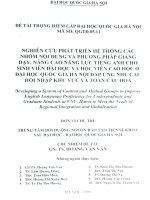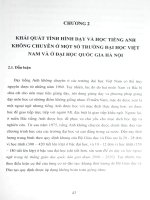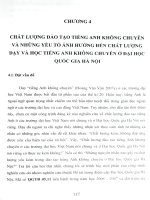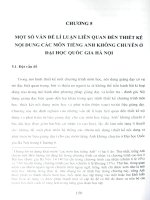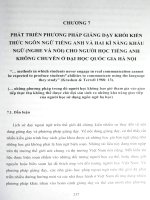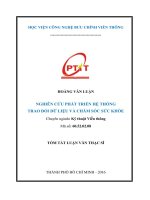Nghiên cứu phát triển hệ thống vi lỏng thao tác và cảm biến tế bào ung thư
Bạn đang xem bản rút gọn của tài liệu. Xem và tải ngay bản đầy đủ của tài liệu tại đây (8.7 MB, 207 trang )
VIETNAM NATIONAL UNIVERSITY
VNU UNIVERSITY OF SCIENCE
Đỗ Quang Lộc
DEVELOPMENT OF A CANCER CELL MANIPULATING
AND SENSING MICROFLUIDIC PLATFORM
(Nghiên cứu, phát triển hệ thống vi lỏng
thao tác và cảm biến tế bào ung thư)
PhD THESIS IN PHYSICS
Hanoi - 2019
VIETNAM NATIONAL UNIVERSITY
VNU UNIVERSITY OF SCIENCE
Đỗ Quang Lộc
DEVELOPMENT OF A CANCER CELL MANIPULATING
AND SENSING MICROFLUIDIC PLATFORM
(Nghiên cứu, phát triển hệ thống vi lỏng
thao tác và cảm biến tế bào ung thư)
Major : Radiophysics and Electronics
Major code: 9440130.03
PhD THESIS IN PHYSICS
SUPERVISOR:
Assoc. Prof. Dr. Chu Duc Trinh
Hanoi - 2019
Pledge - Lài Cam đoan
I hereby declare that this thesis is solely my own work. The data in this thesis
are the results of my personal research and have not been used in other publications
by anyone else.
Tôi xin cam đoan đây là cơng trình nghiên cúu cna riêng tơi. Các so li¾u, ket qua
nêu trong lu¾n án là trung thnc và chưa đưoc cơng bo boi ai khác.
Ngưịi cam đoan/ Ph.D Student
Đo Quang L®c
i
Acknowledgement
Foremost, I would like to express my sincere gratitude to my advisor, Prof. Chu
Duc Trinh, for the continuous support of my Ph.D study and research, for his patience, motivation, enthusiasm, and immense knowledge. My research would have
been impossible without his guidance and supports.
Besides, I would also like to express my appreciation to Dr. Bui Thanh Tung
whose office door was always open whenever I ran into a trouble spot or had a
question about my research or writing. He consistently allowed this paper to be my
own work, but steered me in the right the direction whenever he thought I needed it.
My sincere thanks also goes to Dr. Do Trung Kien. He has offered me many good
opportunities in my life and Ph.D study.
Further, I must express my very profound gratitude Prof. Chun-Ping Jen and I
would like to thank all of my friends at Department of Mechanical Engineering and
Automation for their support during my internship program in National Chung Cheng
University.
I am forever thankful to my colleagues at the Faculty of Physics for their friendship and support, and for creating a cordial working environment.
Last but not the least, I would like to thank my family: my mom and my sisters
for encouraging and supporting me spiritually throughout my life. Most importantly, I
wish to thank my loving and supportive wife, Pham Thi Tuyet, and my beloved
daughter, Anh Thu who provide unending inspiration.
Table of Contents
Pledge
i
Acknowledgement
ii
List of Figures
4
List of Tables
9
Abstract
13
1 Introduction
17
1.1
Introduction of biological cell assay and current situation........................17
1.1.1
1.2
Biological cell assays..........................................................................17
Biological cell sensing systems based on microfluidic.................................20
1.2.1
Overview of the cancer situation and the urgency of cancer cell
diagnosis...............................................................................................21
1.3
1.2.2
Current studies on the detection cancer cells.................................25
1.2.3
Material for microfluidic systems......................................................28
Conclusion of the chapter and the direction of research............................30
2 Biological cell manipulation methods
2.1
Overview of biological cell manipulation......................................................31
2.1.1
Mechanical method..........................................................................32
2.1.2
Optical method................................................................................35
2.1.3
Magnetical method..........................................................................36
1
31
2.1.4
Electrical method . . . . . . . . . . . . . . . . . . . . . . . . .
.38
and Simulation . . . . . . . . . . . . . . . . . . . . . . . . . .
.43
2.2.1
Dielectrophoresis cell manipulation theory . . . . . . . . . . .
.43
2.2.2
Numerical Calculations and Simulations . . . . . . . . . . . .
.47
2.2 Theory
2.3
2.4
Design and Experimental preparation........................................................57
2.3.1
Fluidic chamber design...................................................................57
2.3.2
Micro-electrode structure fabrication process................................57
2.3.3
Microchannel fabrication process....................................................... 60
2.3.4
Cell sample preparation...................................................................63
Results and Discussions...................................................................................65
2.4.1
Fabrication results............................................................................65
2.4.2
Simulation results of biological cell manipulation based on DEP66
2.4.3
Biological cell manipulation based on DEP results.......................67
2.4.4
Section conclusions............................................................................. 69
3 Biological cell sensing, detection and measurement systems70
3.1
3.2
3.3
3.4
Overview of biological cell detection and enumeration techniques..............71
3.1.1
Flow Cytometry based on fluorescence activation method..............72
3.1.2
Impedance Cytometry in fluidic flow............................................75
3.1.3
Biological cell impedance measurements in static fluidic.............80
Theory and Simulation................................................................................83
3.2.1
Biological cell sensing theory.............................................................83
3.2.2
Numerical calculations........................................................................ 85
Design and experimental preparation.........................................................90
3.3.1
Microfluidic flow measurement and detection...................................90
3.3.2
Biological cell concentration and detection...................................95
Results and Discussions...................................................................................97
3.4.1
Object detection in millimeter scale fluidic flow channel.............97
3.4.2
Biological cell detection in microfluidic flow....................................104
3.4.3
Cell detection in fluidic chamber...................................................112
3.4.4
Section Conclusions.............................................................................118
4 Aptamer immobilization based on gold surface
119
4.1
Introduction..................................................................................................119
4.2
A549 cell line detection on aptamer immobilized gold surface...................122
4.2.1
Aptamer immobilization on gold surface process...........................122
4.2.2
Aptamer specificity with A549 cell line experiment....................... 123
4.3
Cell preparation results................................................................................123
4.4
A549 cell line detection on gold surface based on aptamer immobilization
method..........................................................................................................127
4.4.1
A549 cell line immobilization on gold substrate............................127
4.4.2
Aptamer specification experiment with A549 cell line...................128
4.4.3
Aptamer specification experiment with A549 cell line versus time129
4.4.4
Section conclusions.............................................................................130
Conclusions and Future Research
132
Publications
134
References
136
A Signal processing circuit schematic
160
B Biological cell cultivation conditions
164
List of Figures
1.1
Block diagram showing three basic steps for a CTCs cell test..................21
1.2
Schematic showing the tumor metastasis through CTCs/CTM...............24
1.3
Block diagram of a CTC cell separation system using magnetic nanoparticles and biological antibodies....................................................................28
1.4
Molecular structure of Polydimethylsiloxane (PDMS)..............................29
2.1
(A) Image scanning electron microscope system of micro gripper; (B)
Bright field microscopy shows the operation of separating Ecoli K-12
bacteria from blood solutions containing red blood cells...........................34
2.2
Magnetic manipulation methods.................................................................38
2.3
Dielectrophoresis manipulation methods....................................................40
2.4
Electrophoresis and dielectrophoresis: (a) The force exerted on charged
particles and uncharged particles in the uniform electric field; (b) A
neutral particle in a nonuniform electric field creates a total force acting
on the particle because the magnitude of the electric field at the two
ends of the electric dipole is different.........................................................45
2.5
Simulation program interface finite elements using COMSOL.................48
2.6
Sketch view of the simulation chamber......................................................55
2.7
Proposal of biochip sensor based on fluidic chamber.................................58
2.8
Process of fabricating microelectronic structure and packing with microchannel structure..........................................................................................59
2.9
The process of mold fabrication with SU-8 material.................................60
2.10 Process of manufacturing PDMS chip from SU-8 mold............................61
2.11 The process of hooking up the high-precision chip to create the microchannels.
63
2.12 Images of fabricated device. (a) Fabricated chip; (b) working chamber;
(c) fabricated electrode pattern...................................................................65
2.13 The square of the electric field (E2) on micro-electrode pairs with inward
stepping electric field in a numerical simulation........................................67
2.14 The simulation results of the manipulation of cancer cells from a blood
sample using inward (16 V of peak-to-peak voltage - 1 MHz of frequency)
stepping electric fields.................................................................................68
2.15 A549 cells concentration experimental results utilizing step electric field
applied to: (a) 5th electrode pair; (b) 4th electrode pair; (c) 3rd electrode pair;
(d) 2nd electrode pair...................................................................................69
3.1
Components and operating principles of flow cytometry in flow cell
counts (photomultiplier tubes - PMT; forward scatter - FSC; side scatter
- SSC)...............................................................................................................74
3.2
Biological cell impedance sensing in fluidic flow.........................................76
3.3
Biological cell impedance sensing in static fluidic.....................................81
3.4
Model of coplanar capacitor........................................................................85
3.5
Meshing for fluidic chamber simulation.....................................................86
3.6
Electrical model of (a) a single-cell in suspension with complete electric
circuit model; (b) single-cell in suspension with Foster and Schwan’s simplified circuit model; (c) Equivalent electric circuit of the biological cell
detection structure in microfluidic channel; (d) Equivalent electric circuit of sensing system when the cell is located on one sensing electrodes
pair; (e) The simplified circuit model for counting system........................90
3.7
Microfluidic platform for biological cell detection in microlfuidic flow. (a)
Sample is mixed at mixing area (1), then separated at cell manipulation
area (2) before passing through the counting area (3); (b) The detailed
design of microchip proposed for cell impedance cytometry purpose.......92
3.8
Block diagram of the measurement setup...................................................94
3.9
Block diagram of proposed dielectrophoresis microfluidic enrichment
platform with built-in capacitive sensor for circulating tumor cell detection...........................................................................................................96
3.10 Measurement setup: (a) measurement methods; (b) measurement setup
and (c) controlling board.............................................................................98
3.11 Block diagram design of the DC4D fluidic sensor......................................100
3.12 (a)The DC4D output voltage response when a plastic particle crosses
electrodes water channel and salt solution channel; (b) The DC4D output voltage amplitude versus particle volume in various concentration
of salt solution..............................................................................................100
3.13 (a) Capacitance change of sensor with three different materials; (b) Object’s diameters are 25 µm and Maximum differential capacitance
output
vs. particle’s volume........................................................................................101
3.14 Experimental result showing the output signal when air bubbles cross
the sensing area............................................................................................102
3.15 Working principle of PC4D sensor system.................................................103
3.16 (a) Variation of resonance frequency when air bubbles move through
channel filled with different NaCl concentrations solution; (b) Dependence of resonance frequency change on the size of: air bubble moving
through DI water channel, air bubble moving through oil channel, and
water droplet moving through oil channel..................................................104
3.17 Fabricated replaceable microfluidic chip.....................................................105
3.18 Simulation results: Admittance change when a cell with radius of 10 µm
moves across the sensing electrodes in: (a) Sucrose 8.6 % solution; (b)
PBS 1X solution..........................................................................................107
3.19 Simulated admittance change according to: (a) the cell’s vertical position; (b) the cell’s radius..............................................................................108
3.20 Output signal variation when an A549 cell passing over sensing electrodes. (Insets are the position of the cell corresponding to the output
voltage at point A, B, C in the graph. (scale: 100 µmm)..........................109
3.21 Measured voltage trace of A549 cells in continous flow in Sucrose 8.6%
solution and PBS 1x solution......................................................................111
3.22 Simulation results. Electric potential distribution of model: (a) topdown and (b)front cross-section views; (c) Capacitance change versus
number
of cells..............................................................................................................113
3.23 (a) and (b): Bode plot of sensor; (c) The impedance spectroscopy change
versus number of cells on sensing area; (d) Microscopic image of electrode
structure in performance.............................................................................114
3.24 S-180 cell detection operation. A, B, C, and D correspond to increases
in cell number on sensing electrodes (error bar shows the accuracy of
measurement equipment).............................................................................116
3.25 (a) Equivalent circuit of contactless impedance sensor; (b) Block diagram
of circuit for differential impedance measurement.....................................117
4.1
A549 cells immobilization on gold substrate utilizing NH2 aptamer protocol..............................................................................................................122
4.2
Microscopy image of A549 cell line culture process: (a) Before culture;
(b) After culture; (c) Before using Trypsin; (d) After using Trypsin........125
4.3
Cells counting of the A549 cell line for the experiment using counting
chamber........................................................................................................126
4.4
A549 cells immobilization performance after being washed: (a) 25µM
NH2-Aptamer; (b) 10µM NH2-Aptamer....................................................127
4.5
Positive control experiment.........................................................................128
4.6
Negative control experiments......................................................................129
4.7
Aptamer specification experiment with A549 cell line versus time: (a) After
cell injection; (b) After 15 minutes incubation and washing.....................130
A.1 Schematic diagram of dielectrophoresis manipulation control circuit.......161
A.2 Schematic diagram of signal processing circuit for cell detection in fluidic
flow...................................................................................................................162
A.3 Schematic diagram of signal processing circuit for cell detection in fluidic
hamber..............................................................................................................163
List of Tables
2.1
Comparison between common manipulating mechanisms.........................44
2.2
Parameters of fluidic chamber model............................................................56
2.3
Size and dielectric properties of Red blood cells (RBC) and cervical
carcinoma cell [7, 68, 81, 139, 171]............................................................56
3.1
Comparison between common cytometry methods....................................83
3.2
Material permittivity parameters used in simulation [162].......................87
3.3
Geometry parameters used in simulation...................................................87
3.4
Simulation material parameters [162, 179].................................................89
3.5
Parameters of microfluidic sensor..................................................................89
4.1
Control experiment for aptamer specificity determination........................124
4.2
A549 cell viability versus time when suspended in PBS 1X solution and
Sucrose 8.6% solution..................................................................................126
List of Abbreviations
ACAlternative Current
ACEOAC Electro-Osmosis
BioMEMSBio-Micro Electro-Mechanical Systems
BSABovine Serum Albumin
C4DCapacitively Coupled Contactless Conductivity Detection
CCDCharge Coupled Device
cDEPContactless Dielectrophoresis
CECapillary Electrophoresis
CTCsCirculating Tumor Cells
CTDNACirculating Tumor DNA
CTMCirculating Tumor Microemboli
CTMatCirculating Tumor Materials
DAQData Acquisition
DCDirect Current
DC4DDifferential Capacitively Coupled Contactless Conductivity Detection
DEPDielectrophoresis
DNADeoxyribonucleic Acid
EDC1-Ethyl-3-(3-Dimethylaminopropyl)-Carbodiimide
eDEPElectrode Dielectrophoresis
EGFREpidermal Growth Factor Receptor
EPElectrophoresis
EpCAMEpithelial Cell Adhesion Molecule
ESPR1Epithelial Splicing Regulator 1
FACSFluorescenceactivated-Cell-Sorting
FASTFiber-Optic Array Scanning Technology
FEMFinite Element Method
FISHFluorescence In Situ Hybridization
FSCForward Scatter
GASIGeometrically Activated Surface Interaction
HIVHuman Immunodeficiency Virus
ICIntegrated Circuit
iDEPInsulator-Based Dielectrophoresis
ISETIsolation By Size Of Epithelial Tumor Cells
ITIMSInternational Training Institute For Materials Science
LCInductor Capacitor
MACSMagnetic-Activated Cell Sorting
MDCKMadin-Darby Canine Kidney Epithelial
MEMS/NEMSMicro/Nano Electro-Mechanical Systems
nDEPNegative Dielectrophoresis
PBSPhosphate-Buffered Saline
PC4DPassive Capacitively Coupled Contactless Conductivity Detection
PCBPrinted Circuit Board
pDEPPositive Dielectrophoresis
PDMSPolydimethylsiloxane
PMTPhotomultiplier Tubes
RBCsRed Blood Cells
RT-PCRReverse Transcription Polymerase Chain Reaction
SELEXSystematic Evolution Of Ligands By Exponential Enrichment
SPMBsSuperparamagnetic Beads
SSCSide Scatter
WBCsWhite Blood Cells
WGAWheat Germ Agglutinin
µ-EISMicro Electrical Impedance Spectroscopy
µ-MACSMicrofluidic Magnetic Activated Cell Sorting
Abstract
The urgency of the project
Currently, cell assays are one of the indispensable processes for diagnosing
diseases or evaluating pathological conditions of patients. In Vietnam, as well as in
many other countries around the world, the cell assays for detecting, analyzing and
evaluating
the number and types of cells presenting in clinical samples are often
performed in medical center where fully equipped with facilities and services.
However, when taking traditional tests, patients often have to pay high costs and spend
a lot of time waiting
at crowded medical centers. In cell assays, in addition to
classifying and labeling target cells, the process counting the numbers, assessing
density, and cell concentration in patient’s samples also plays an important role in
influencing to subsequent tests. In medical centers and research laboratories, cell
counting, as well as the determination of target cell concentrations in patient’s
samples, are often performed using some common methods such as limiting dilution
(limiting -dilution culture), ELISPOT test method or Fluorescence-Activated Cell
Sorting (FACS) method based on flow cytometry principle. With the cell assays that
require high throughput, such as CD4 + T lymphocyte counts in HIV diagnosis and
monitoring, flow cytometry is often preferred due to the ability to analyze cells
quickly and capable of providing high throughput.
However, the commercial machine and devices are often high cost, requiring
tech- nically qualified technicians, not suitable for using in limited resources areas,
such as in lower-level hospitals. For that reason, many research groups around the
world are interested in reducing costs by restricting the use of expensive optics and
optical de- vices, using unlabeled detection (label-free) approach, simplifying the
structure, etc.. Along with the development of science and technology, specifically, the
emergence of
microelectromechanical systems integrated in microfluidic structures, miniaturized cell
assays based on microfluidic have been developed by many research groups to perform
cell enumeration on micro-chip platform toward simpler, quicker and more reasonable,
especially suitable for using in limited substance and facilities.
The integration of cell detection and counting systems based on microfluidics not
only brings advantages in terms of reducing time performing tests, sample volume,
as well as minimizing the chemical substance needed for the tests, these microfluidic
devices also help patients shortening the testing time, minimizing the number of samples needed and reducing the economic burden. Besides, the microfluidic platform also
allows the integration of components and sub-processes pretreatment such as cell lysis
or cell staining on microfluidic chips.
On the other hand, the microfluidic chips may disposable, that can provide a
disinfection environment, avoiding the risk of cross-contamination, the risk of danger
in manipulating the samples. The development of microfluidic biological cell detection
can carry this device to laboratories, enabling biological studies in cancer detection,
drug development, genetic research and possibly brings new opportunities for
biomedical research. Therefore, conducting research to develop living cell counting
and detection systems for rapid cell test applications is a highly practical and
scientific issue.
Based on analyzing the requirements as mentioned above, in this thesis, the author has studied and proposed a system capable of testing living cells based on microfluidic techniques to enrich, detect and quantify biological cell concentration. The
proposed system includes of a micro-manipulation structure and embedded impedance
sensor. This is perfectly suitable for using for living cell fast detection and diagnostic
kits where the sensing chips are used only once and are replaced after each use.
Scientific and practical significance
This is an interdisciplinary topic, involving many areas such as electronics, control, microfluidic, physics, biology and microfabrication. The sensor system will detect
the presence of a specific cell and evaluate the number of that cells in the sample solution. The successful implementation of this study will provide a tool that can quickly
detect the number of cells and cell population can be monitored without the use of
very expensive commercial equipments. With regard to medical devices, the product
of the proposed device also provides a tool to detect and count the number of cells.
Object and purpose of research
The object of the dissertation is the biological cell enrichment and detection system; specifically in this case, A549 and Sarcoma 180 cell lines. The proposed structure
integrates with microfluidic systems that allow enrichment, cell detection in fluid samples with a very small volume and a short duration of the experiment. The objective
of the research is to research, design and perform the experimental test on proposed
systems using micro sensor chips based on the principle of impedance sensors. The
sensor chip is able to detect the presence of cancer cells in patient’s samples based on
the change impedance between built-in sensor electrodes. The output signal data of the
sensor chip is recorded and processed to provide the number of cells in the
microfluidic channel and chamber of the sensor chip.
Methods and scope of research
In order to realize the specific objectives, the thesis implements the main
research contents including an overview of research, simulation, fabrication, and
experimental measurement to evaluate simulation results. Specifically, the study of the
design of the microfluidic structure integrated with manipulating electrode structures
and sensing electrodes. Modeling and simulating the response of objects in
microfluidic environ- ments including microfluidic chamber and microfluidic channel.
In addition, this study implements circuit control design, manipulate cells in the
microfluidic chamber and signal processing circuit to detect the presence of cells in the
sensor area of the system. Finally, the biological cell counting is experimental
performed in standard solution using bio-chips and manufactured circuit board.
The thesis structure
The thesis consists of 4 main chapters.
Chapter 1: In this chapter, first, a brief introduction to cell assays and cell assays
applications is presented. Then, review of researches and applications of microfluidic
technology in cell assays in domestic and international research groups is provided.
Finally, the results of developing fluidic flow detection systems in millimeter and mi-
crometer channels are given.
Chapter 2: This chapter delve into the structure of a microfluidic chip used in cell
manipulation
and
enrichment.
Then,
theory
and
application
of
dielectric
electrophoresis force to manipulate biological cells in fluidic chamber are presented.
Basic theories used in simulation tools by COMSOL Multiphysics utilizing the finite
element method are also provided. Next, information of experimental processes
including the fabrication of microfluidic chips based on microfabrication technology,
biological cell preparation process is introduced. Finally, experimental cell
manipulation performance is reported and compared with simulation results.
Chapter 3: In this chapter, two microfluidic system structures to detect cells in
the microfluidic chamber and in the microfluidic channel based on impedance sensing
approach are presented. Numerical calculation results based on impedance technique
followed by experimental results are reported. In this chapter, experimental investigation results on object and fluidic flow detection based on impedance approach are also
presented and discussed.
Chapter 4: In this chapter, the issue of cell detection based on aptamer-biosensor
is presented, including the combination of impedance sensor methods with gold electrode surface functionalization process with aptamer specific to target cell. Experimental results of the cell culture process and examines biological cell viability after
culture and preparation are given. Then, in order to determine ability of aptamer immobilization on gold electrodes, several control experiments have been performed and
reported.
Finally, the author concludes the research study and proposes the next research
direction.
Chapter 1
Introduction
1.1 Introduction of biological cell assay and
current situation
1.1.1 Biological cell assays
Cell assay is defined as the measurement and analyzation of biological cell’s response according to the external physical and chemical stimulations. The cell’s responses are divided into the biochemical alterations of intracellular and extracellular
media, cell morphology, motility, and growth properties [4]. These responses of
biologi- cal cells can assist to distinguish cell phenotype and are typically monitored in
a culture dish or a multi-well plate, while more recently microfluidic devices have
been utilized. A cell assay performed in a microfluidic device is alternatively termed
an on-chip assay. Biological cells are the primary elements of life and are often
considered to represent basic models for complex biological systems. Some studies, such as
morphological analysis and cell growth, can only be evaluated by cell assays. Other
studies, such as cell biochemical analysis, can also be performed by simple tests such
as molecular assay to analyze molecular interactions. Molecular testing is faster and
less complex but can lead to confusing conclusions because it is impossible to mimic
the complex and special properties of the intracellular environment. Therefore, cell
experiment analysis is more suitable for the study of living systems. However, there
are some limitations such as
costly implementation, time consuming and much more complex than other types of
analysis.
Cell tests are usually performed in culture plates based on multi-well plates
(molds containing 96, 384 wells, etc.). While culture plates require large volumes of
solutions and chemical substance, multi-well plates require only microliter of sample
volume and allow simultaneous analysis of various cell types. Readers will read optical
in- formation designed to analyze samples at the same time using technologies such as
fluorescence and polarization, luminescence or absorption. Multi-well discs and disc
readers have become the standard tool for medium and high-throughput screening in
cell and biomolecular tests.
Microfluidic technology is utilized in microchip fabrication whereas it provides
the micrometer fluidic channel, which allows integrating numerous processes in only
one platform. Hence, the experiment time and sample volume can be reduced when
experiments are performed on the microfluidic platform. Thus, microfluidics allows
ex- periments to be carried out that cannot be performed simply by miniaturizing and
mechanizing conventional laboratory procedures using robotics and microplates. Microfluidic technology creates new opportunities for high throughput cell screening devices [36].
Otherwise, microfluidic devices provide various benefits in cell assays due to the
homologous between cell size and the microfluidic channel dimensions (the depth and
width are normally 10 - 100 µm). At the micrometer-in-size channels, the fluidic flow
is characterized by laminar flow. The combination between laminar flow and the
diffusion provides the formation of highly resolved chemical gradients across small
distances. An- other advantage of microfluidic devices is the increased surface-tovolume ratio which facilitates the heat and mass transfer, as well as scaling the
electrical and magnetic fields that are often used in cell analysis. Hence, the cell assays
performed in a mi- crofluidic device require a small volume (i.e., sub-microliter
volumes) of cell sample, the concentration of cell sample is kept at high concentration,
which facilitates the detection sensitivity.
However, microfluidic system does have some disadvantages for cell assays. For
instances, the difficulty of controlling many reagents simultaneously; the high surfaceto-volume ratio of microchannel enhances the adsorption of molecules onto channel
walls which directly reduces the effective concentration of reagents [4].
Typically, micro flow provides flow rates usually smaller than 10 µl/min. Hence,
it provides the ability of continuous and uniform perfusion of media as well as steady
culturing conditions. When designing the microfluidic channels for cell assays, the
flow is designed to have small shear stress impacts on the adherent cells while the cells
in suspension can be assayed while carried by bulk micro flow. Manipulation
techniques can be used for suspension cells such as hydrodynamic trapping or cell
immobilization on functionalized surfaces [102, 187].
The fluidic flow experiments in the micro-systems are usually carried out by
electroosmotic flow or pressure controlled flow. The electroosmotic current in many
cases is not suitable for transporting cell fluid flow due to the large polarization and
the electric field can create side effects for cells in the flow. Therefore, in many studies, microfluidic channel flow is often controlled by controlling off-chip or micropump built-in micro-system (on-chip) structure by means of soft-lithography for cell
assays. In fact, to satisfy biological compatibility, microchannels are often made of
silicon, glass or polydimethylsiloxane (PDMS) material. Glass and PDMS are
materials for transmitted light, making it easier to monitor the process in microsystems using opti- cal methods. For long-term tests, the sterilization of micro-channel
is needed to avoid infection in the cell solution. Tests involving adherent cells often
require the canal wall to be pre-treated by attaching suitable proteins (e.g., Fibronectin,
collagen, or laminin) to enhance adhesion. On the other hand, when experimenting
with suspension cells, channel walls can be coated with bovine serum albumin (BSA)
to prevent nonspecific adhesion [102, 187].
Wheeler et al. focused on the use of microfluidic technology for single cell analysis and described in detail that cell manipulation is a problem that can be solved
with microfluidic systems [187]. Photolithography techniques using masks and photoresist materials are used to create micro-channel systems based on PDMS materials.
Studer et al. have developed a microfluidic device that can be used to organize and

